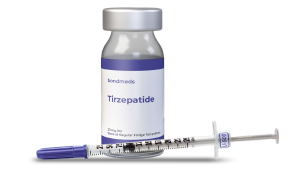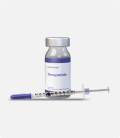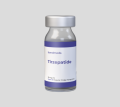- $50 off your first month
Tirzepatide Injection (Zepbound Injection)
$299.50 $249.50 first month
What is Tirzepatide ?
Tirzepatide is a medication that has been developed to aid in weight loss. It works by mimicking the actions of two hormones, GLP-1 (glucagon-like peptide-1) and GIP (glucose-dependent insulinotropic polypeptide), which are naturally involved in regulating appetite and metabolism. By activating the receptors for these hormones, tirzepatide helps to reduce hunger, improve the body’s insulin response, and promote weight loss.
What is Tirzepatide Injection?
Tirzepatide Injection refers to a specific form of the medication Semaglutide, used primarily for weight management and treatment of type 2 diabetes. It is a branded injectable medication that contains Semaglutide, a glucagon-like peptide-1 (GLP-1) receptor agonist. It is designed to help manage weight and control blood sugar levels.
What is difference between Tirzepatide and Ozempic & Wegovy
Tirzepatide, Ozempic, and Wegovy are distinct medications used to manage type 2 diabetes and assist with weight loss, though they differ in composition and mechanisms. Tirzepatide (branded as Mounjaro) combines the effects of both GLP-1 and GIP receptor agonists, offering a dual-action approach to enhance insulin secretion, improve blood sugar control, and support weight loss. In contrast, Ozempic, which contains Semaglutide, functions as a GLP-1 receptor agonist to regulate insulin secretion, decrease appetite, and slow gastric emptying, primarily targeting diabetes management with secondary weight loss benefits.

New FDA-approved medication for weight loss

Acts on two hormone receptors, GLP-1 and GIP, to enhance weight loss effectiveness.

15-22.5% of their body weight over the course of one year.
How it Works
1. Medical History
2. Online Visit
3. Receive Meds

Tirzepatide Injection
Up to 20% body weight loss
What do we get?
$299.50/
Get started with the special intro offer
What’s included
Frequently asked Questions
What is Tirzepatide?
Tirzepatide is a medication used to improve blood sugar control in adults with type 2 diabetes. It is also being studied for weight management
How is Tirzepatide administered?
Tirzepatide is administered once weekly by subcutaneous injection using a single-dose prefilled auto-injector pen. The available doses are 2.5 mg, 5 mg, 7.5 mg, 10 mg, 12.5 mg, and 15 mg.
What is the recommended starting dose?
The recommended starting dose is 2.5 mg injected subcutaneously once weekly. After 4 weeks, the dose is typically increased to 5 mg once weekly. If further glycemic control is required, the dosage may be raised in increments of 2.5 mg, not to exceed a total of 15 mg once weekly.
Can Tirzepatide be used with other diabetes medications?
Yes, Tirzepatide can be used as monotherapy or in combination with other antidiabetic medications, including insulin. However, combining it with insulin or insulin secretagogues might elevate the risk of hypoglycemia; therefore, dose adjustments could be required.
What are the common side effects of Tirzepatide?
Common side effects include nausea, vomiting, diarrhea, decreased appetite, and constipation. These side effects are typically mild to moderate and generally diminish over time.
Are there any serious risks associated with Tirzepatide?
Tirzepatide has been shown to cause thyroid tumors in animal studies, though it is not known if this occurs in humans. Patients ought to notify their physician if they have a history of thyroid cancer or Multiple Endocrine Neoplasia syndrome type 2 (MEN 2).
What should I do if I miss a dose?
If you miss a dose, take it as soon as you remember, as long as it is within 4 days of the missed dose. If more than four days have passed, skip the missed dose and take the next one at the regular time.
Can I drink alcohol while taking Tirzepatide?
It’s best to talk with your doctor about alcohol consumption while taking Tirzepatide. Alcohol may impact blood sugar levels and potentially heighten the risk of hypoglycemia.
How should I store Tirzepatide?
Store Tirzepatide in the refrigerator. If needed, it can be kept at room temperature for up to 21 days. Tirzepatide should not be frozen and must be protected from light.
What should I tell my doctor before starting Tirzepatide?
Inform your doctor if you have any allergies, a history of pancreatitis, stomach or bowel problems, or if you are pregnant or planning to become pregnant. Additionally, please provide a list of all the medications you are currently taking.
Tirzepatide Injection
Drawing your medication
Watch this video to learn how to inject your medication using the vial and insulin needles: (https://www.youtube.com/watch?v=wXjQHAxopzk)1. Check the medication label to ensure it matches the dosage prescribed by your provider.2. Remove the lid from your vial.3. With the syringe cap still on, pull back the plunger to the 20 mark (0.2 ml) on your syringe to fill it with air.4. Remove the syringe cap, insert the needle into the rubber top of the vial, and push all the air into the vial.5. Turn the vial upside down and pull the plunger back to the prescribed amount of medication.6. If air bubbles are present, tap the syringe with your finger until the bubbles rise, then gently push the plunger to push the air back into the vial.Injecting Your Medication:1. Rotate your injection site to be at least 1.5 inches away from the last site.2. Cleanse the chosen area with an alcohol wipe and let it dry.3. Pinch a 2-inch fold of skin between your thumb and index finger.4. Hold the syringe like a pencil or dart and insert the needle at a 45 to 90-degree angle into the pinched-up skin.5. Hold the syringe with one hand and slowly push the plunger to inject the medication until it’s fully depressed.6. Remove the needle and gently hold an alcohol pad on the injection site without rubbing.How should injectable Tirzepatide compound be stored?
If needed, each vial can be stored unrefrigerated at temperatures not to exceed 86°F (30°C) for up to 21 days.Do not freeze Tirzepatide. Do not use Tirzepatide if frozen.
Store Tirzepatide in the original carton to protect from light.
Additional Information
LIFESTYLE MODIFICATION:
While we do not expect you to follow a specific diet, it is imperative that you begin and continue a diet with a calorie deficit. “Intermittent fasting” is an option for some patients, but we recommend seeing a dietician if you need assistance in choosing a specific diet which will meet your goals.
An individualized exercise plan should also be created and adhered to during your weight loss program. Both of these should become permanent lifestyle modification, which will continue long after your pharmaceutical weight loss treatment is complete.
You should not expect to see a significant weight loss with any pharmacological therapy unless you combine with permanent lifestyle modification of both diet and exercise.
SIDE EFFECTS
This medication may have several common side effects.
For Constipation:
The constipation is a result of these medications which slows gastric emptying time. There are a few things that you can do to reduce your chances of developing constipation including:
- Increase your fiber intake to 30 g/day, including vegetables, whole grains.
- Increase your water intake to at least 64 oz of water daily.
- You may need to add over-the-counter fiber supplements such as Metamucil or Benefiber.
If your constipation is severe, you can also consider taking over-the-counter medications such as Colace or senna which help to soften the stool and make it easier to pass or you could consider MiraLAX as a way to stimulate bowel movements.
If your constipation continues after the use of the above suggestions, please discontinue the use of the medication and notify your provider for the next steps.
Please seek in-person care if at any time you develop severe abdominal pain or nausea that is a result of the constipation.
For Nausea/heartburn:
- Avoid fried, greasy, or fatty foods and foods high in sugar.
- Eat slowly, and eat smaller meals. If needed, move to 6 small meals a day spaced 6-8 hours apart.
- Eat foods that are light and bland.
- Drink clear or ice-cold drinks.
- You can try to inhale deeply an alcohol pad holding a minimum of a centimeter from your nose. Some patients find this as effective as medications such as Zofran used for nausea.
- Try moving your injection site to the thigh region; this has been noted to decrease side effects.
For belching, you can try over-the-counter GasX. Nausea tends to improve over time as your body gets used to taking the medication.
For Diarrhea:
- Keep up with hydration, make sure to hydrate throughout the day.
- Pepto Bismol – take as directed, please note it will turn stool dark/black.
- After about 2 days of diarrhea, if still persistent, Imodium (OTC also) and just take it as directed on the packaging.
For fatigue, you can try adding in over-the-counter vitamin B12.
For Localized skin reaction:
- Use over-the-counter Cortaid and if needed, take your injection out of the refrigerator 10 minutes prior to injection.
WHEN SHOULD I STOP TAKING Tirzepatide injection?
Stop taking Tirzepatide and consult your doctor if you experience:
- Severe side effects: Persistent nausea, vomiting, stomach pain, or signs of pancreatitis (severe abdominal pain).
- Allergic reactions: Hives, facial swelling, or trouble breathing.
- Thyroid concerns: Neck swelling or trouble swallowing.
- New health issues: Significant kidney/liver issues or pregnancy.
Always consult your doctor before stopping.





